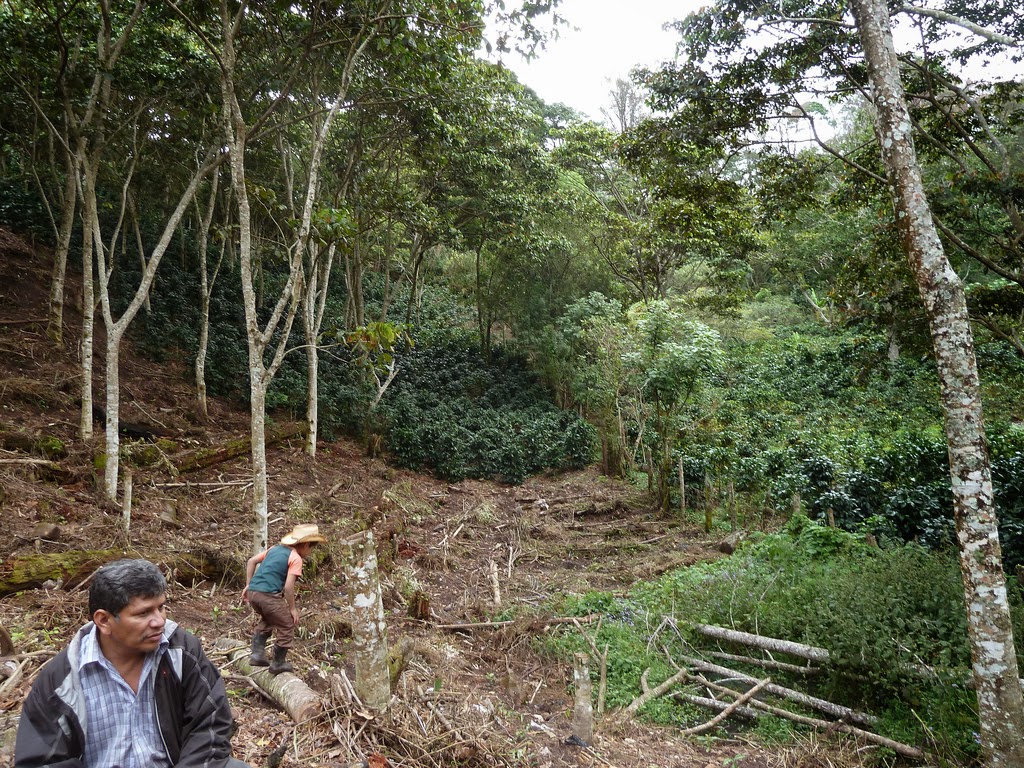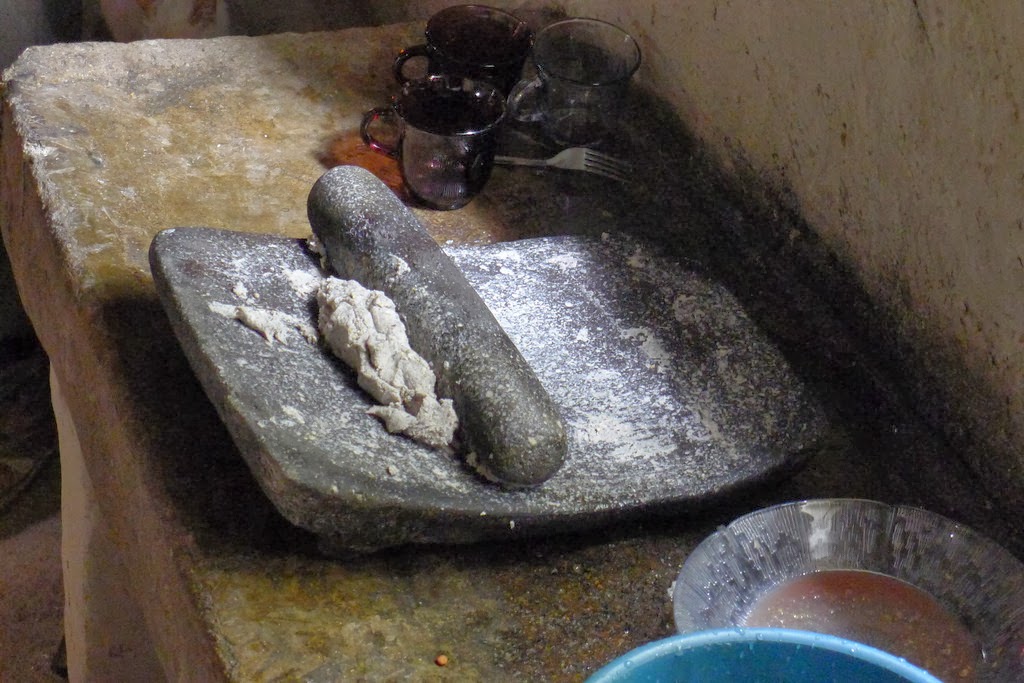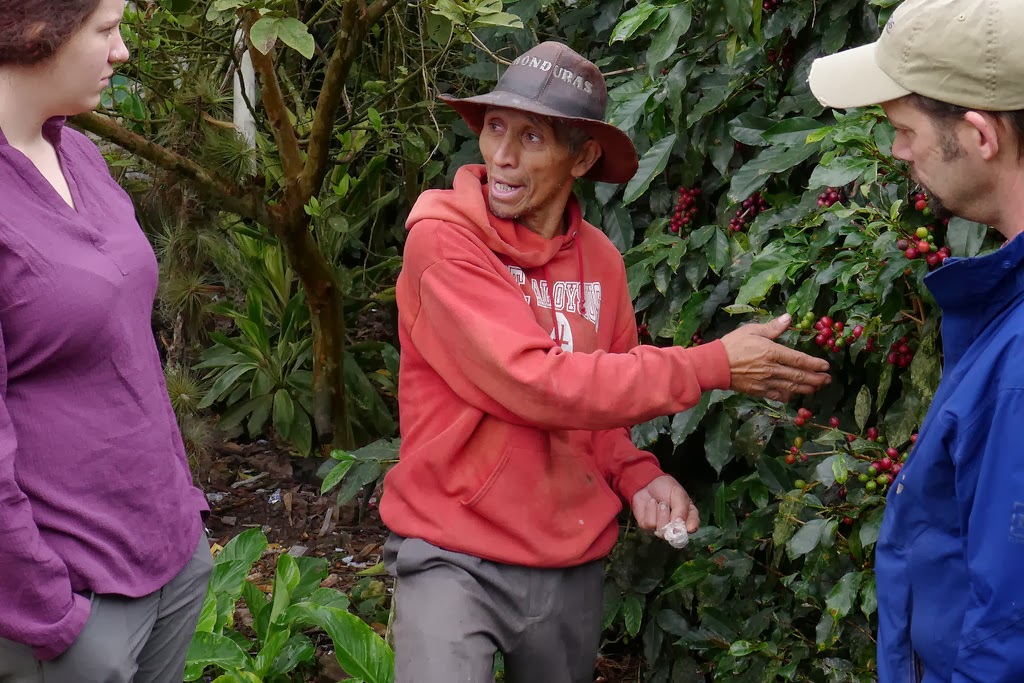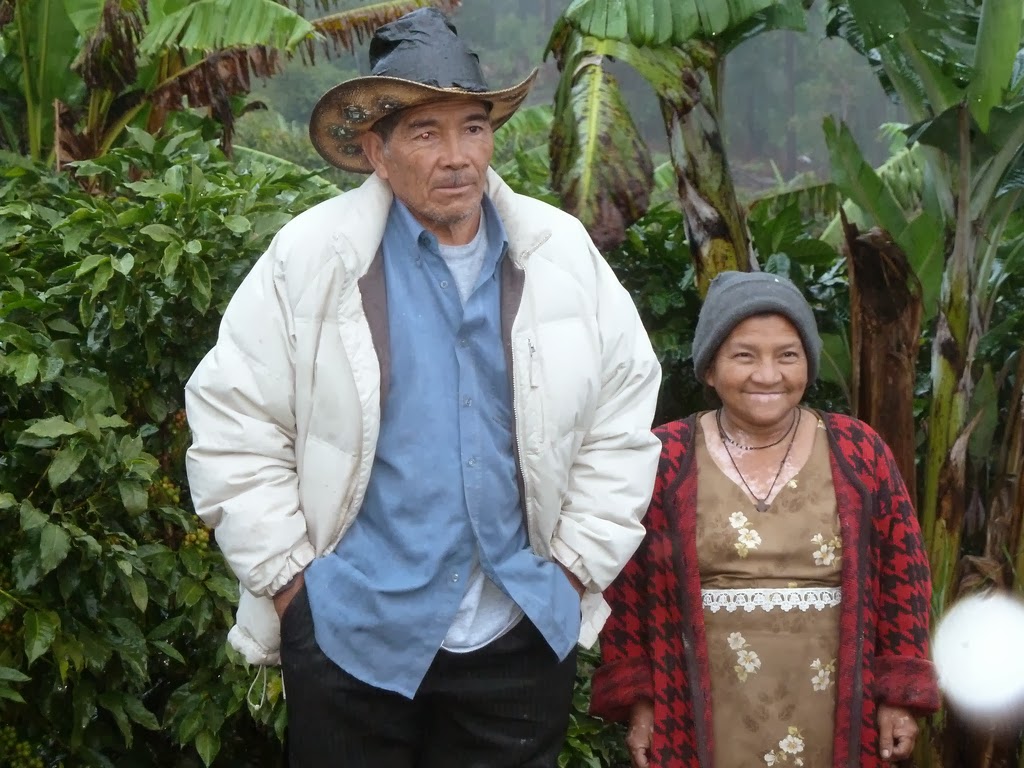"Brrrrrmmmm" "Brrrrrmmm" "Brrrrrmmmm"
 |
| On the way up the mountain to Don Chico's organic plot |
As we hike along the road to Don Chico's organic coffee plot, his grandsons Federico and Sergio (estimated ages 8 and 6) are running circles around us while making motorcycle sounds. They are our guides for the hike and have also brought along a piece of black rope to play with. They uncoil the rope and stretch it between them, slingshotting each other around. One boy slides off the road and the other boy throws him the rope and pulls him up the embankment. Soon they are pulling the rope to stretch across the road and attempting to envelop the gringos who are walking along at our own pace. Alex is briefly imprisoned and he then escapes with a run to the delight of the children. The boys are guiding us up and up and up to the top of the hill that serves as the visual edge of the valley that is El Sute. It is a steep climb and the boys keep running back and forth in their rubber boots, getting twice the hike we do. It is fitting that Federico and Sergio are guiding us to Don Chico's plot because everything he does as a farmer seems to be for their benefit.
 |
| Sergio (left), Federico (right) |
 |
| Alex and the boys (I don't recognize the neighbor boy in the blue) |
Don Chico has a generosity of spirit and a persistence which has made him the principal farmer and chief promoter in the COFEACOMA organic coffee co-op. When the co-op president, Adalid, needed someone to help him move the coffee to the processing and bagging facility, Don Chico was there to help and wouldn't quit until the job was done. Later, when the coffee had to sit for a couple months before shipping, Don Chico went on his own accord to check that the quality was holding strong. Don Chico provided extra coffee to complete the partial bags that others had sent, and he even sent an extra 100 pounds of coffee to Farmer to Farmer on speculation that we would be able to sell it and pay him later. Don Chico's house serves as the unofficial center for the both the coffee co-op and for the rural lending group in El Sute. He insists on hosting us whenever we arrive in El Sute and will not accept payment for food or lodging. When we arrived in Honduras this year, Don Chico took half a day to ride his horse off the mountain and meet us. After our meeting we declared the intention to visit him first on our trip. His face went dark, and he explained that we would have to wait until later in the trip. His grandson Federico was at another family place in Yoro, halfway across Honduras, and Don Chico did not want him to miss our visit. He announced that he would travel to Yoro and retrieve Federico and he could host us in 5 days time.
 |
| We switched hats. They thought it was funny. |
 |
| Spanish moss in the trees on the way up to Don Chico's organic plot. |
Now Federico and Sergio are on the road, cresting the ridge with boundless energy, and we are wondering where they are taking us. Hector and I have been to Don Chico's organic plot before and this is not the way. We are wondering if the boys are playing a joke on us. "Just a little further!" they keep saying. And so it is, seemingly always; but soon we have turned off from the road and we are walking back towards the far side of the ridge along a narrow dirt path. We walk through someone's yard and keep walking right into a coffee patch. "Just a little further!" Finally we are where they wanted to show us. It is a newly planted plot of coffee of about an acre, all under scattered shade trees. Each plant looks like it was planted within the last couple months. The new growth is strong and green. The boys show us the remains of the nursery where the plants came from, and we can see that they must have watered the plants with water from a spring that is bubbling up on the edge of the plot. The shade trees are a mix of leguminous guama and towering pines. I can see why they brought us here. There is a lot of work present in this new plantation, and it is a hopeful vision for the future.
 |
| The view from the road up by the ridge near Don Chico's organic coffee plot. |
 |
| The cleared area is the new plantation. Behind it is an established plantation that belongs to Federico and Sergio. Note the spring on the right. |
 |
| The remains of the coffee nursery. |
From this plot we can now see the other plot that Don Chico usually takes us to. All we have to do is hike up to the ridge a little ways. As we walk, we ask Federico if the coffee patch we are walking through now is also Don Chico's. He says no, it is "de nosostros," meaning "ours." At first we don't understand, but then Federico explains that Don Chico has given that patch of coffee to his two grandsons. Federico is proud of his coffee. When we get to Don Chico's original plot, we are initially worried. He clearly has the Roya, the dreaded coffee rust, and it seems that many of his plants are dying. But then as we crest the ridge, we see that most of his plants are resisting the Roya and are they loaded with green leaves and deep red coffee cherries. Don Chico has succeeded by planting a diversity of varieties and most of them are resistant to the Roya. When we return to Don Chico's house we have a good dinner and we try to teach the boys to play "Uno," which appears to be the first card game they have ever played. Of course, both boys win hands and seem to get all the "Draw Four Wild" cards (beginners luck!). Don Chico is curious to learn what we thought of his coffee plot. He values our opinion. We reassure him that things are not dire.
 |
| Don Chico's coffee |
 |
| The view from Don Chico's |
 |
| Don Chico is growing coffee under the shade of pine trees. Some believe it can't be done, but this patch looks very good. |
Don Chico's full name is Francisco Alvarado Medina. He has a little over 4 acres in organic coffee and is in the process of converting more land into organic production. He has chickens, pigs, horses, and a few milk cows, and he collects manure to make prepared composts. His organic plot on the ridge is at high elevation at 1750 meters above sea level. Don Chico has completely embraced organic farming and even has posted a sign at the entrance to his farm describing it as a "Finca Organica," so I am surprised to learn that he has only been a co-op member for three years. Last year he grew 4000 pounds of coffee, 1500 of which he sent to Farmer to Farmer, the largest supplier of coffee for COFEACOMA. He grows the varieties Catuay, Lempira, and IHCAFE 90. His wife, Simona Vazquez Vazquez, and his daughter Berta manage the harvest, which involves family members and paid help. The coffee is de-pulped using a manual de-pulper and fermented and washed in a concrete water tank. The coffee is dried in greenhouses on metal screens, and he prefers not to store the dried coffee on-site, but rather brings it to the valley where it can be stored in a drier climate. In addition to coffee and the animals, Don Chico also grows corn, beans, vegetables, bananas, citrus, and hardwood shade trees.
 |
| Don Chico's farmstead |
 |
| Sleeping in the drying shed. |
 |
| The cutest kitty in the world at Don Chico's |
 |
| The kitten was happiest on my foot. |
In the past three years, we have seen striking improvements on his farm. He has built two coffee-drying greenhouses, a wooden storeroom, and a Toyota pick-up truck sits in the yard. When we ask about the pick-up, we learn that six farmers came together to purchase the pick-up. He is also a leader in the rural lending group, which guards members' capital in a bank account and lends it out within and outside of the group, functioning like a bank. Don Chico's lending group has started a little general store in the community, where each member takes a month-long turn staffing the store, and all members share in the earnings. Don Chico has helped bring a potable water system to the community, as well as new roads, and electricity is on the way. Where other farmers seem to be quite independent, the farmers in El Sute have many collective ventures, and Don Chico seems to be right in the center of each of them. He is a community leader, but he knows that all he does, he does for the future of his family. He is 66 years old and he has 2 daughters, Berta and Vilma, and 7 grandchildren. He wants Farmer to Farmer to know that he is very grateful for the opportunity to sell his coffee to us.
Don Chico's coffee was evaluated by our tester as somewhere between "very good" and "excellent," earning a 76.5 rating on the 100-point cupping scale. The comments are: "clean, mellow acidity, hints of wheatgrass, bit thin. But a good cup." I'll say: a very good cup.
 |
| Don Chico, Federico, Bertha (Daughter), and Sergio |
 |
| The whole crew. The family on the right is Don Mario's (a curious neighbor - maybe next year will join the organic coffee co-op) |


































.jpg)

















